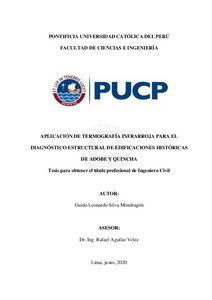| dc.contributor.advisor | Aguilar Vélez, Rafael | |
| dc.contributor.author | Siva Mondragón, Guido Leonardo | |
| dc.date.accessioned | 2020-07-23T18:45:45Z | |
| dc.date.available | 2020-07-23T18:45:45Z | |
| dc.date.created | 2020 | |
| dc.date.issued | 2020-07-23 | |
| dc.identifier.uri | http://hdl.handle.net/20.500.12404/16698 | |
| dc.description.abstract | Las propuestas de intervención y restauración que garanticen la conservación de una edificación histórica deben estar orientadas a solucionar los problemas detectados en un diagnóstico estructural previo. El uso de métodos no destructivos durante la ejecución del diagnóstico estructural es recomendable debido a su carácter no invasivo. Dentro de este tipo de métodos se encuentra la termografía infrarroja que tiene la ventaja de proporcionar información en tiempo real y no requerir un contacto directo con la superficie estudiada. El objetivo de la presente tesis es explorar una herramienta de diagnóstico estructural no destructiva mediante el uso de termografía infrarroja pasiva y activa desde un enfoque cualitativo. Para alcanzar este fin se realizó una revisión bibliográfica de la aplicación de termografía infrarroja en ingeniería civil. Además, se realizaron ensayos de termografía infrarroja pasiva y activa en dos casos de estudio en laboratorio para evaluar las ventajas que proporcionan ambos métodos en la visualización de inserciones y anomalías estructurales. Luego, se formularon protocolos de ensayos de termografía infrarroja pasiva y activa, recolección de datos y post-procesamiento de datos (integración de la termografía infrarroja con fotogrametría). Por último, los protocolos propuestos fueron validados mediante su uso en el diagnóstico estructural de una casona de adobe y quincha del siglo XX ubicada en Lima y la fachada de un módulo de adobe. Los resultados obtenidos muestran que la termografía infrarroja se presenta como una útil herramienta de diagnóstico estructural para estudiar anomalías superficiales y sub-superficiales, visualizar sistemas estructurales como la quincha y detectar cambios de material. Por otro lado, la integración de termografía infrarroja con fotogrametría demostró ser capaz de proveer información espacial de las anomalías detectadas en los termogramas y posibilita diferenciarlas de irregularidades geométricas. Finalmente, los protocolos propuestos demostraron ser herramientas que facilitan la ejecución de ensayos de termografía infrarroja y que podrían ser empleados por profesionales involucrados en el ámbito del estudio y conservación de patrimonio cultural. | es_ES |
| dc.description.abstract | Intervention and restoration proposals that guarantee the conservation of a historic building must be aimed at solving the problems detected in a previous structural diagnosis. The use of non-destructive methods during the execution of a structural diagnosis is recommended due to its non-invasive nature. This type of method includes infrared thermography, which has the advantage of providing information in real time and does not require direct contact with the surface being studied. The objective of this thesis is to explore a non-destructive structural diagnostic tool using passive and active infrared thermography from a qualitative approach. To this end, a bibliographic review of the application of infrared thermography in civil engineering was carried out. In addition, passive and active infrared thermography tests were performed in two laboratory case studies to evaluate the advantages provided by both methods in the visualization of insertions and structural anomalies. Then, protocols for passive and active infrared thermography, data collection and post-processing (integration of infrared thermography with photogrammetry) were formulated. Finally, the proposed protocols were validated through their use in the structural diagnosis of a 20th century adobe and quincha house located in Lima and the façade of an adobe module.
The results indicate that infrared thermography is presented as a useful structural diagnostic tool to study surface and sub-surface anomalies, visualize structural systems such as the quincha and detect material changes. On the other hand, the integration of infrared thermography with photogrammetry proved to be capable of providing spatial information of the anomalies detected in the thermographs and makes it possible to differentiate them from geometric irregularities. Finally, the proposed protocols proved to be tools that facilitate the execution of infrared thermography tests and that could be used by professionals involved in the study and conservation of cultural heritage. | es_ES |
| dc.language.iso | spa | es_ES |
| dc.publisher | Pontificia Universidad Católica del Perú | es_ES |
| dc.rights | info:eu-repo/semantics/openAccess | es_ES |
| dc.rights.uri | http://creativecommons.org/licenses/by/2.5/pe/ | * |
| dc.subject | Análisis estructural (Ingeniería) | es_ES |
| dc.subject | Construcciones de adobe | es_ES |
| dc.subject | Construcciones de quincha | es_ES |
| dc.subject | Tecnologia infrarroja | es_ES |
| dc.subject | Termografía | es_ES |
| dc.subject | Monumentos históricos--Mantenimiento y reparación | es_ES |
| dc.title | Aplicación de termografía infrarroja para el diagnóstico estructural de edificaciones históricas de adobe y quincha | es_ES |
| dc.type | info:eu-repo/semantics/bachelorThesis | es_ES |
| thesis.degree.name | Ingeniero Civil | es_ES |
| thesis.degree.level | Título Profesional | es_ES |
| thesis.degree.grantor | Pontificia Universidad Católica del Perú. Facultad de Ciencias e Ingeniería | es_ES |
| thesis.degree.discipline | Ingeniería Civil | es_ES |
| renati.advisor.dni | 40591707 | |
| renati.advisor.orcid | https://orcid.org/0000-0002-8175-8950 | es_ES |
| renati.discipline | 732016 | es_ES |
| renati.level | https://purl.org/pe-repo/renati/level#tituloProfesional | es_ES |
| renati.type | https://purl.org/pe-repo/renati/type#tesis | es_ES |
| dc.publisher.country | PE | es_ES |
| dc.subject.ocde | https://purl.org/pe-repo/ocde/ford#2.01.01 | es_ES |






